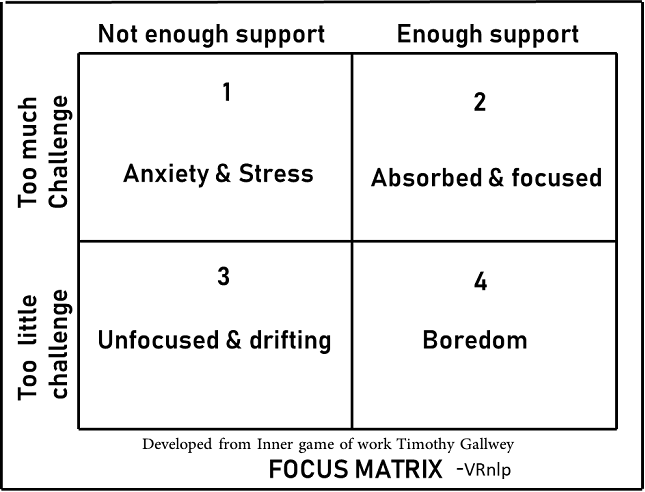Focus Matrix

The article is written getting inspiration from a thought given by Timothy Gallwey in his book The INNER GAME of WORK.
The following matrix is an extension of Timothy’s thought on focus
Focus is the key to success in any endeavor, be it leading, be it managing, be it coaching, be it listening , whatever the work , focus marks the difference that makes the difference.
It is our experience that the moment we want to focus on the task on hand, from somewhere into the mind distraction creeps in and seeps in and spoils the charm of attention.
We are forced to make a conscious effort to drive away distraction. This could either fatigue us or frustrate us.
Timothy Gallwey talks of ‘inner environment’ for focus. Gallwey observes that the reason for distraction is anxiety, or stress or boredom. He says if the challenge is too much and the needed support is not available, then anxiety and stress distracts us from focus; on the contrary too little challenge and enough support gives boredom,
Based on this example I have extended his thought to draw a matrix and consolidated human mind’s response to life situation around us.
How we are impacted by the climate around us is illustrated in the matrix now.
Quadrant 1 : Too much challenge and not enough support
Sense of certainty gives security. Security is what people seek, yet people look for challenge in a safe environ to fill the thrill of the brain. At the same time if the challenge is too much and not enough safety or support is provided, then performance anxiety sets in causing stress and fatigue. This stress distracts the individual from focusing peacefully on the task
Autocratic Leadership style is reflected in this climate
Quadrant 2 : Too much challenge with sufficient support & safety
We can say this is an ideal condition for productivity and undeterred focus to give one’s best. In this eustress fills the mind powering the effort for faster results. Positive outcome is spontaneously expected and all our attention is fully focused on the task on hand. There is no iota of doubt or disbelief about positive outcome and so there is absorbed attention to details leading to successful outcome or goal achievement.
Servant leadership is reflected in this model here
Quadrant 3 : Too little challenge and not sufficient support
Perhaps this is a non-conducive atmosphere for learning and development, If the individual is not challenged by any task, where there is no predetermined dead line, where there are no parameters for performance evaluation, the mind will automatically drift and dive to what next. A moment to moment existence may sap the energy leading to despondency and doubt, thereby loss of self-assurance for any future challenges. Focus is the first casualty in this atmosphere
This model reflects Laissez-faire leadership style
Quadrant 4: Too little challenge and enough support
When members go through motion without any challenge they tend to fall into a sedentary routine leading to boredom. There are no demands, there is no accountability, and so here too anxiety may set in about prospects for growth and development.
Bureaucratic leadership style creates this kind atmosphere.
Conclusion:
Focus is a matter of mental discipline. Discipline gets inculcated by inner and outer climate which dynamically impact each other.
True inspiration comes by challenging one’s own limits on an ongoing basis. For this self-initiative to become a part of nature, sufficient nurturing is needed from the atmosphere.
Any organization that focuses on employee empowerment through planned learning & development finds its people in quadrant 2
V RANGANATHAN,
www.vrnlp.com
